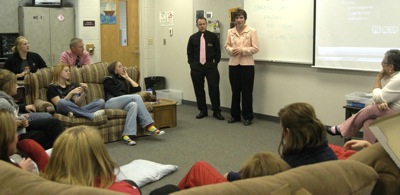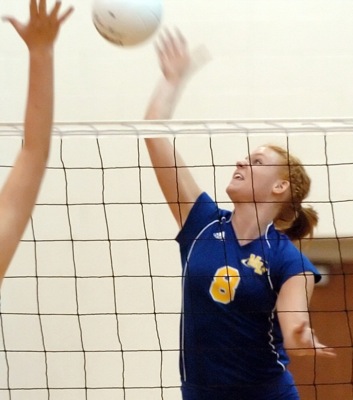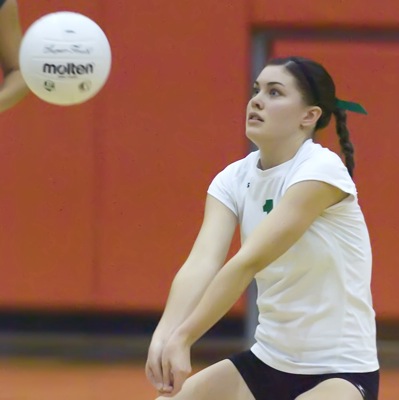Wednesday, October 22nd, 2008
It's lights, camera and action at St. Henry High School
By Shelley Grieshop

Photo by Shelley Grieshop/The Daily Standard
Instructors Ryan Gasser and Tonya Koenig of Northwest Ohio Educational Technology of Bowling Green field questions and give comments to students in the new contemporary literacy course at St. Henry High School.
ST. HENRY - Look out Hollywood, the Redskins are on the air.
A new senior-level course at St. Henry High School has not only produced a creative group of broadcasters, it has spawned an 18-minute video to be shown schoolwide on Friday.
"Excellent!" shouts one senior girl in the contemporary literacy class after a premier showing on Tuesday.
"The Scoop" is a newscast/documentary created by the students with guidance from their teacher, Melinda Gregor. The segment begins as a music video with a teen struggling to get up in the morning while tunes such as "I Don't Want To Go To School" play on.
As the video continues, studio anchors and "on the scene" reporters talk about events at the school and interview athletes, a homecoming queen and other students during a variety of activities.
Later, a weather report is given, including a simulation of two reporters with umbrellas in the midst of Hurricane Ike. On a more serious note, the video includes a 9/11 tribute.
A portion of the video was taped at the ABC/FOX studios in Columbus during a recent class field trip.
On hand for the video's debut is Tonya Koenig, a teacher with the Northwest Educational Technology, and Bowling Green State University student/instructor Ryan Gasser, who came to the school to critique the production during the premier.
"It was a heartfelt piece, good pics," says Gasser, a fifth-year student majoring in sports broadcasting.
Gasser and Koenig give several suggestions for the "heartfelt piece," as they call it. The pair advises the class to work on transitioning from segment to segment and to improve the quality of the audio, perhaps by the use of lapel mics.
Koenig, a professional videographer, also notes a minor problem as the video fades from clip to clip.
"Let the camera roll," Koenig says, explaining that extra taping can be cut out. "You'll love it later, those will be your bloopers."
Gregor laughs, explaining the class already has plenty of blooper material "and it's only the first nine weeks."
The entire production was completed with a minimal amount of equipment, Gregor says. Last year the classroom had just two laptops; this year five computers were added and a few Flip digital camcorders, which take amazingly crisp video for their small size, Gregor says.
The new class, which combines English language arts and 21st century technology, is boosted financially by a Learn and Serve project grant of $3,000 for the first of seven years. More money is available during the grant term following yearly applications, says Kim Norris, the school's director of student services.
"The most important thing about this is it speaks the kids' language," she says. "We can show them an open door to the future."
Gregor, an English teacher, says the course gives her students hands-on experience. Activities scheduled for later in the year include students making videos for individuals, businesses and organizations within the community.
"We're blending skills and helping students prepare for jobs that don't even exist yet," the teacher says. "All these skills will serve (students) better than just writing research papers."


